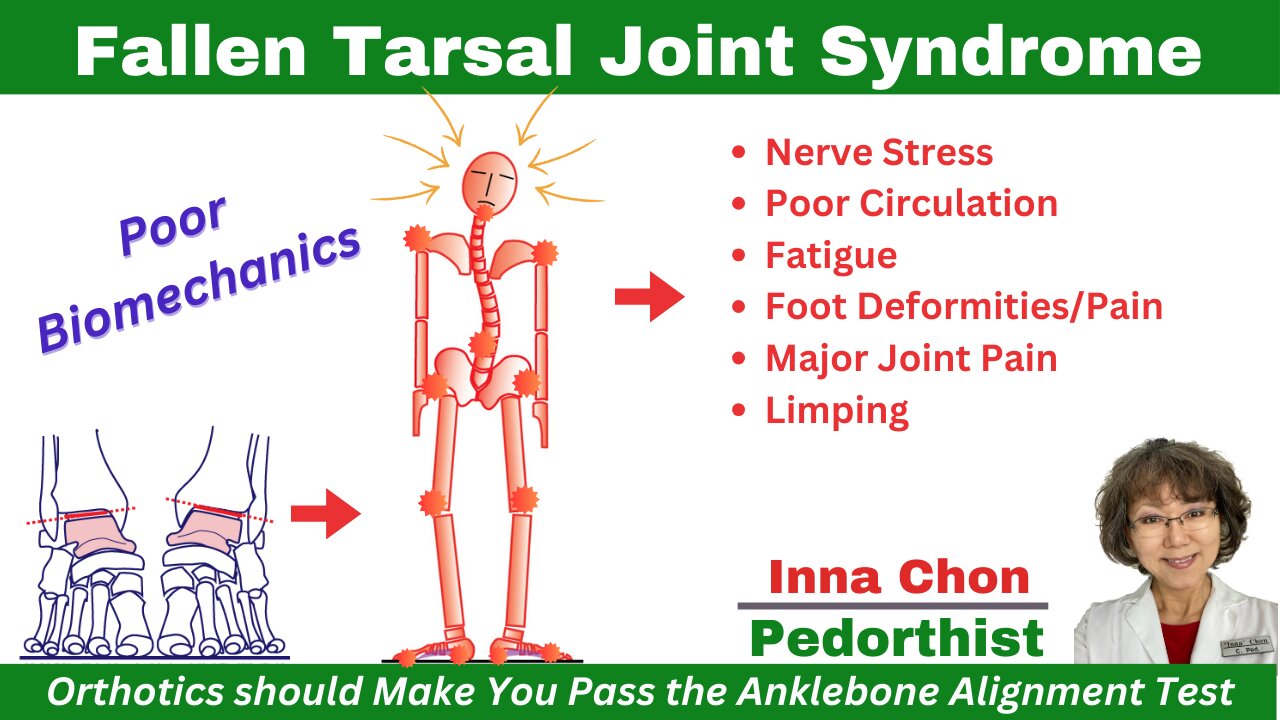Premium Only Content

Fallen Tarsal Joint Syndrome
Inna Chon, a pedorthist & anklebone alignment specialist, approaches the analysis of foot structure & mechanics from the unique perspective of an animator, drawing on her background as a Disney animator. This gives her insights differ significantly from traditional approaches. She developed a method for conducting an Anklebone Alignment Test. W/ her custom orthotics, she aligns people’s anklebones at the same height & teaches individuals how to stand, walk, & run correctly to maintain proper alignment.
This video is about Fallen Tarsal Joint Syndrome not many people talk about. The Tarsal Joint is falling w/ each step causing bio-mechanical problems in our body. Bio-mechanical problems are not just postural & joint problems like in an automobile w/ air leaking tires or a building w/ falling foundation. It is lot more complicated. Because on the fallen tarsal joint, our body compensates constantly to keep the body from falling. This Tarsal Joint should not fall out of its normal range of motion just like the other joints. However, when we are walking, our entire body weight passes through this tarsal joint & make the Joint to fall by our weight. When tarsal joint falls, the entire foot bones go out of alignment including the anklebone on which the leg bone stands. This systematically puts our entire body out of alignment from the feet up causing many complicated problems in the body. Here are the problems of the Fallen Tarsal Joint.
1. Nervous system stress: when the tarsal joint falls, all the foot nerves and the nerves around the misaligned major joints send the signals to our brain constantly until we align the Tarsal joint. This definitely stresses our brain.
2. Poor Blood Circulation: Body standing w/out the alignment interrupts the circulation at every weight-bearing joints, especially at the foot bottom. Because blood vessels are all connected. This blockage affects the entire circulation.
3. Energy level decreases: Moving a body without the alignment take lot more energy & cannot lift a weight w/out compensating that consumes energy. So fallen tarsal joint wastes lots of energy & can lead to chronic fatigue.
4. Foot Deformities: Fallen Tarsal Joint misaligns the entire foot bones. Consequently deforming the foot with bunion, hammer toes, & flat feet. The tarsal joint falls little by little w/ each step deforming the foot shape little by little over the decades. People don’t realize until the deformities become obvious. Also, the bump or a protrusion in the middle of the lateral arch is one of the foot deformities not many people know about.
5. Foot pain: The fallen tarsal joint is the cause of most foot pain like plantar fasciitis, heel spur, metatarsalgia, neuroma.
6. Limping: Usually both tarsal joints falling in different degrees & angles makes one leg shorter than the other. W/ one leg shorter than the other, our body CANNOT avoid limping. We can check the leg length discrepancy by pressing down on top of the hip bones while standing.
7. Posture/Major Joint issues: Moving w/out the alignment affects the everything in & around the joints negatively. The cartilages, meniscus, ligaments, & tendons. And the body posture becomes poor. Once align the anklebones at the same height, systematically, from the bottom, the knee, hip joints can be aligned, so the spine. Then even the face line becomes straight. When the tarsal joint falls severely, the our body started to stoop & worsens balance causing the elderly to fall easily.
8. Ligaments/tendon problems in the foot & leg: All the tendons of the leg muscles pass the ankle joint & most of them attach to the foot bones in the tarsal joint, except the tendons that move the toes. As a result, when the tarsal joint falls, all the foot ligaments/tendons twist & overstretch to wrong directions. This causes tendonitis in Achilles tendon, tibialis anterior (shin splint) tendon, tibialis posterior tendon, & peroneal tendon. All postural & joint problems are the signals telling us to Align the Anklebones. And I found out how to do the Anklebone Alignment test (AA test). So, when we are getting orthotics, shoes, socks & cushions, whatever we put on our feet, we need to do the AA test to make sure they all work together aligning our anklebones & doing the AA test time to time to make sure the shoes bottoms are wearing out nicely w/out tilting. & we need to walk correctly by putting our body weight straight down onto the anklebones on the high medial arch, not on the lateral arch. Then our body can function efficiently w/ alignment being able to utilize its full strength & full range of motion. For the overall body health & before any treatment, especially joint treatments, we need to align the anklebones first w/ the proper orthotics. Only then, all the treatments & healings can take place properly in alignment. Otherwise, all the treatments and healings are happening out of alignment.
-
 15:09
15:09
Talk Nerdy Sports - The Ultimate Sports Betting Podcast
39 minutes ago3/29/25 -Saturday Sharps: 10 Best Bets, 5 Parlays, & 3 Stone Cold Locks to Smash the Books
-
 LIVE
LIVE
SwitzerlandPlayIT
3 hours ago🔴 Easy Going Saturday - The Next Generation?
126 watching -
 23:23
23:23
MYLUNCHBREAK CHANNEL PAGE
18 hours agoAustralia Was Found
13.2K24 -
 LIVE
LIVE
ThePope_Live
2 hours agoComing out of retirement for Rebirth Island with @IcyFPS
237 watching -
 LIVE
LIVE
BigTallRedneck
1 hour agoFORTNITE - SOLO GRIND FOR OPAL PICKLE
64 watching -
 LIVE
LIVE
smokenfiretv
6 hours agohappy Saturday
47 watching -
 16:13
16:13
Russell Brand
1 day agoBill Maher EXPOSES Covid Lab Leak Lies LIVE ON AIR
97.7K316 -
 LIVE
LIVE
Eternal_Spartan
3 hours agoLive Now! | Join The Channel on a New Adventure In Skyrim PC (Slight Mods) - USMC Veteran!!!
359 watching -
 2:07:55
2:07:55
Jewels Jones Live ®
2 days agoTRUMP’S AGENDA ADVANCES | A Political Rendezvous - Ep. 116
32.7K20 -
 LIVE
LIVE
IamTyrantt
3 hours ago $2.24 earnedGaming on Rumble!!
105 watching